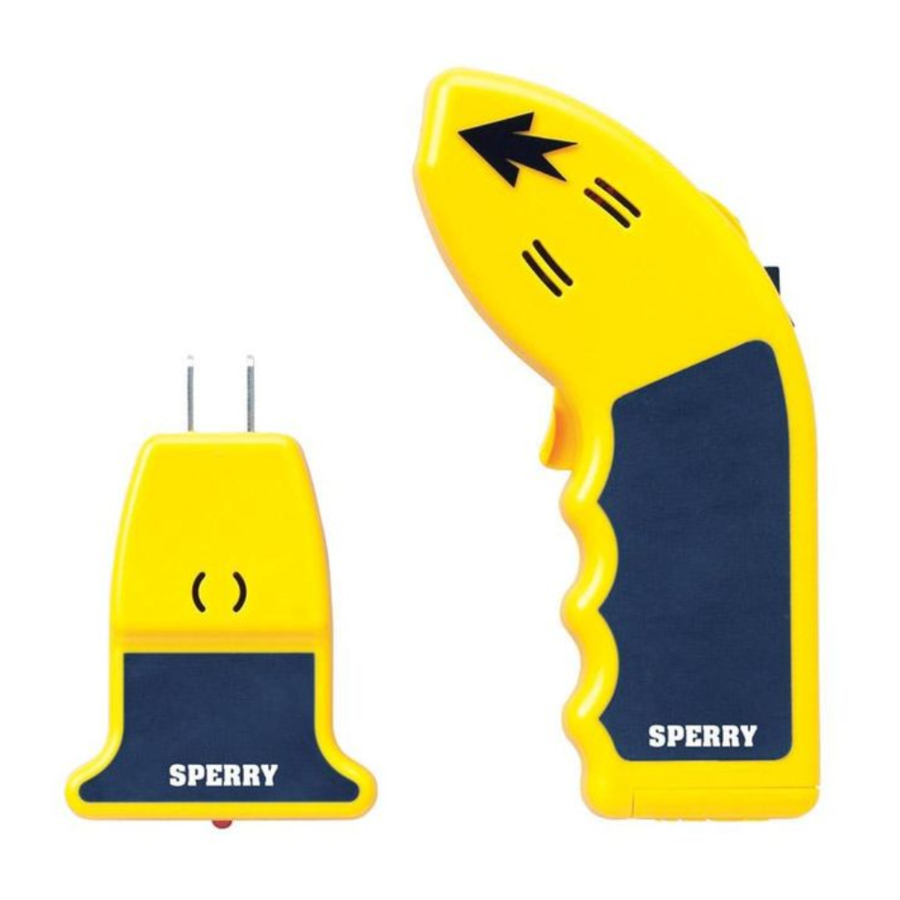
Sperry instruments CS-550A - Circuit Breaker Finder Manual
- Operating instructions (2 pages) ,
- Operating instructions (2 pages)
Advertisement

FEATURES
- UL Listed to both US and Canadian Standards
- One Year Limited Warranty
- Locates AC Breakers or Fuses
- No need to interrupt power
- Distinctive signal
- Audible and visual indication
- Does not interfere with sensitive electronic equipment
- Self-calibrating receiver with audible and visual indicators.
- Self-powered transmitter with audible and visual indicators.
PREPARATION FOR USE

FIG. 1
- Install a 9-volt alkaline battery (battery not included).
- Reinstall battery cover.
- Test battery by turning on unit (rocker switch)
- L.E.D. will light brightly indicating the battery is in good condition.
TESTING THE TRANSMITTER AND RECEIVER

FIG. 2
- Plug the transmitter into a powered electrical wall outlet.
- L.E.D will flash and beeper will sound at approximately seven times per second.
- Turn on receiver and place target on the tip against rear of transmitter (as shown).
- Receiver L.E.D. will flash and beeper will sound in time with the transmitter.
- While continuing to hold receiver against rear of transmitter press and hold calibration switch.
- The receiver will stop responding with-in one to two seconds.
- Release calibration switch, receiver will again respond to the transmitter's signal.
- This completes the test; turn off the receiver to reset the calibration circuit to full sensitivity.
LOCATING A CIRCUIT BREAKER

FIG. 3
- With the transmitter plugged into an AC outlet to go the circuit breaker panel and open the cover.
- Turn on the receiver and place target on the tip firmly against the first circuit breaker in the panel.
- Press and hold the calibration switch while moving the receiver across the circuit breakers.
- When the receiver responds to a circuit breaker stop movement until the receiver stops responding, then continue moving the receiver to the next breaker.
- During the calibration process the receiver may respond to more than one of the circuit breakers in the panel, each time this occurs wait for the receiver to stop responding before moving to the next circuit breaker.
- After scanning all the circuit breakers in the panel release the calibration switch and rescan the circuit breakers.
- Only one breaker will now produce a response in the receiver.
- While continuing to hold the receiver against this breaker turn off the breaker, this will remove power to the remote transmitter and the receiver will cease producing a response. This confirms that the transmitter is no longer receiving power.
- Turn off receiver; additionally this resets the calibration circuit if another scan is desired.
- Always confirm that power to the outlet has been removed by noting the absence of sound and light when in the presence of the transmitter.
- Unplug transmitter when not in use.
OVERHEAD LIGHTING

FIG. 4
The circuit breakers controlling ceiling lights may also be identified by using a light socket adaptor or socket to clip lead adaptor such as the Sperry CSA-300A Adapter Set (sold separately) as shown in figure 4.
SAFETY NOTE
Since the routing of electrical wiring in the home can take many forms, it is possible for additional hot wires controlled by different circuit breakers to be present in the outlet box. Because of this possibility, it is recommended that an AC Voltage Sensor such as the Sperry Model VH-601A (sold separately) be used to test for the presence of additional hot wires in the outlet box prior to performing any work inside the box.
LIGHT DIMMERS
High power light dimmers may interfere with the operation of the unit by giving a false response when scanning the circuit breaker panel. The presence of such a light dimmer will produce a much higher flash and beep rate from the receiver compared to the normal rate of seven times per second. It is recommended that any dimmers in operation be set to full power, or shut off when using the Circuit Breaker Finder.
SWITCH CONTROLED OUTLETS
Because wall switches are sometimes used to control outlets, be sure to turn on these switches prior to plugging in the transmitter.
BATTERY LIFE
While powered, the receiver will consume 10ma from the battery. The L.E.D. in the receiver will rapidly become dim when the battery voltage drops below 8 volts and will completely extinguish at 7.5 volts. Replace the battery when the L.E.D. fails to light or becomes noticeably dim. Turn off receiver when not in use to prolong battery life.
SPECIFICATIONS
Working Voltage Range 80-140V max. to ground
Frequency: 50-60Hz
Operating Temperature: 32 to 122F(0-50C)
Storage Temperature: -4 to 158F(-20-70C)
Power Supply:
Receiver: One (1) 9V
Transistor Type Battery (NEDA #1604) Part # B-4
Dimensions:
Transmitter: 3.3"H x 2.6"W x 1.1"D (83 x 67 x 28mm)
Receiver: 6.3"H x 3.4"W x 1.1"D (159 x 86 x32mm)
Weight:
Transmitter: 2.5 oz. (70g)
Receiver: 5.1 oz. (145g)
Phone:1-800-645-5398 Toll Free or 1-631-231-7050
Fax:1-631-434-3128
Email: cat@awsperry.com
www.awsperry.com

Documents / ResourcesDownload manual
Here you can download full pdf version of manual, it may contain additional safety instructions, warranty information, FCC rules, etc.
Download Sperry instruments CS-550A - Circuit Breaker Finder Manual
Advertisement







Need help?
Do you have a question about the CS-550A and is the answer not in the manual?
Questions and answers